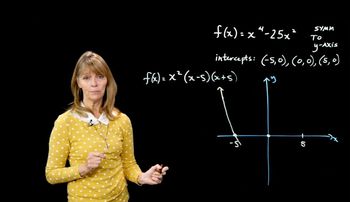Table of contents
- 0. Review of Algebra4h 16m
- 1. Equations & Inequalities3h 18m
- 2. Graphs of Equations43m
- 3. Functions2h 17m
- 4. Polynomial Functions1h 44m
- 5. Rational Functions1h 23m
- 6. Exponential & Logarithmic Functions2h 28m
- 7. Systems of Equations & Matrices4h 6m
- 8. Conic Sections2h 23m
- 9. Sequences, Series, & Induction1h 19m
- 10. Combinatorics & Probability1h 45m
4. Polynomial Functions
Dividing Polynomials
Problem 40
Textbook Question
In Exercises 33–40, use synthetic division and the Remainder Theorem to find the indicated function value. f(x)=6x^4+10x^3+5x^2+x+1;f(− 2/3)
 Verified step by step guidance
Verified step by step guidance1
Step 1: Write down the coefficients of the polynomial function. For the function f(x) = 6x^4 + 10x^3 + 5x^2 + x + 1, the coefficients are 6, 10, 5, 1, and 1.
Step 2: Write down the value of x that you are trying to evaluate. In this case, x = -2/3.
Step 3: Set up the synthetic division table. Write the value of x on the left, then draw a vertical line. Write the coefficients of the polynomial on the right of the line, then draw a horizontal line underneath.
Step 4: Perform synthetic division. Bring down the first coefficient (6 in this case) to the bottom row. Multiply this number by x (-2/3), and write the result under the second coefficient. Add these two numbers and write the result in the bottom row. Repeat this process for all coefficients.
Step 5: The last number in the bottom row is the remainder. According to the Remainder Theorem, this is the value of the function at x = -2/3. So, f(-2/3) is equal to the remainder.
Recommended similar problem, with video answer:
 Verified Solution
Verified SolutionThis video solution was recommended by our tutors as helpful for the problem above
Video duration:
2mPlay a video:
Was this helpful?
Key Concepts
Here are the essential concepts you must grasp in order to answer the question correctly.
Synthetic Division
Synthetic division is a simplified method for dividing a polynomial by a linear binomial of the form (x - c). It involves using the coefficients of the polynomial and performing a series of multiplications and additions to find the quotient and remainder efficiently. This technique is particularly useful for evaluating polynomials at specific values, as it reduces the computational complexity compared to traditional long division.
Recommended video:

Higher Powers of i
Remainder Theorem
The Remainder Theorem states that when a polynomial f(x) is divided by a linear divisor (x - c), the remainder of this division is equal to f(c). This theorem allows us to evaluate the polynomial at a specific point without performing the entire division process. In this case, it helps in finding the value of f(-2/3) directly by applying synthetic division.
Recommended video:

Higher Powers of i
Polynomial Evaluation
Polynomial evaluation involves substituting a specific value for the variable in a polynomial expression to determine its output. This process can be done using various methods, including direct substitution, synthetic division, or the Remainder Theorem. Understanding how to evaluate polynomials is essential for solving problems in algebra, as it allows for the analysis of function behavior at specific points.
Recommended video:
Guided course

Introduction to Polynomials
Related Videos
Related Practice

